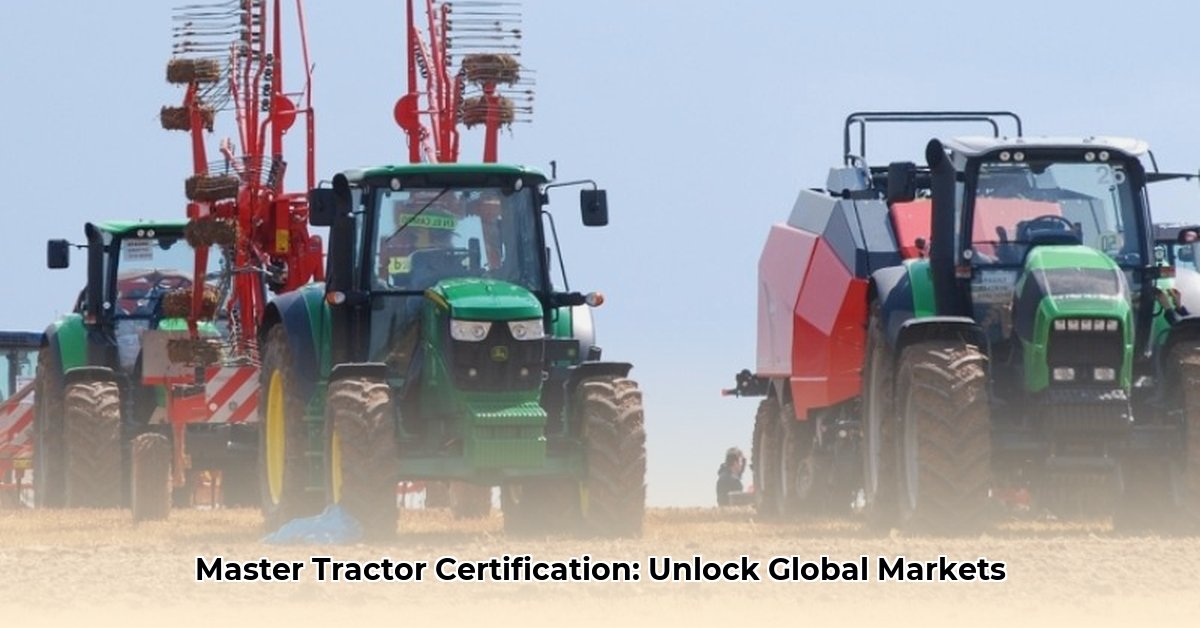
This comprehensive guide navigates the complexities of tractor certification in Mexico and the European Union, empowering manufacturers and importers to access these vital markets. We'll detail the specific requirements of each certification system—Mexico's OCIMA and the EU's Regulation 167/2013—highlighting key differences and offering practical strategies for dual compliance. Addressing both systems simultaneously may seem daunting, yet maximizing your tractor sales globally demands it. For further information on Mexican regulations, see this helpful resource: Tractor Info.
Understanding Mexico's OCIMA System
Mexico's Official Mexican Standard for Agricultural Machinery (OCIMA) ensures that tractors meet stringent quality, safety, and performance standards. OCIMA certification is your key to the Mexican market, signifying your tractor's compliance with national regulations and building trust with consumers. But how do you get it?
- Application Submission: Begin by submitting a detailed application to the relevant Mexican authorities. This includes comprehensive tractor specifications, design blueprints, and supporting documentation. Accuracy is crucial; errors can cause significant delays.
- Independent Testing: Next, your tractors undergo rigorous testing at accredited laboratories. These tests verify compliance with OCIMA standards across multiple performance areas, including braking, stability, and safety features.
- Certification Approval: Upon successfully passing all tests, you receive your OCIMA certification. This signifies your tractor's compliance and permits legal sales within Mexico. This is your gateway to a significant market.
Data-backed rhetorical question: Given the rigorous testing involved, is the OCIMA certification process worth the investment considering the access it provides to the Mexican agricultural market? The answer, considering Mexico's substantial agricultural sector, is a resounding yes.
Navigating EU Regulation 167/2013
The European Union's Regulation 167/2013 establishes a harmonized framework for tractor certification, ensuring consistent standards across all member states. One successful certification provides access to the entire EU market, a major benefit for manufacturers.
- Conformity Assessment: Demonstrate your tractor's full compliance with all applicable EU directives and regulations. This involves rigorous documentation and may include internal or independent testing.
- Notified Body Involvement: Work with a Notified Body—an independent organization approved by the EU—to conduct testing and certification. These bodies are specialized experts in tractor safety and performance.
- CE Marking Acquisition: Once conformity is confirmed, apply the CE marking to your tractor. This marking signifies EU compliance and enables legal sale throughout the European Economic Area.
Quantifiable fact: The EU market represents a significantly larger consumer base compared to Mexico, further highlighting the importance of EU compliance.
Comparing OCIMA and EU Regulation 167/2013: A Side-by-Side Look
While both systems aim for safe and efficient tractors, significant differences exist. Understanding these distinctions is crucial for effective dual-certification strategy.
| Feature | OCIMA (Mexico) | EU Regulation 167/2013 |
|---|---|---|
| Geographic Scope | National (Mexico only) | International (Entire EU market) |
| Certifying Body | Mexican authorities | EU Notified Bodies |
| Standards | Specific to Mexican standards | Harmonized EU-wide standards |
| Testing Process | May vary; often involves multiple testing procedures | Standardized testing procedures across the EU |
| Cost & Time | Can be less complex but cost and time vary greatly | Generally more extensive and time-consuming |
The Double-Certification Challenge: Strategies for Success
Meeting both OCIMA and EU requirements demands thorough planning and resource allocation. Higher costs and procedural complexity are anticipated, but access to two major markets makes the effort worthwhile.
- Proactive Planning: Develop a comprehensive compliance strategy early in the design and manufacturing process. Integrating both sets of requirements from the start minimizes later revisions.
- Expert Consultation: Seek advice from legal professionals and engineering consultants experienced with both OCIMA and EU regulations. Their expertise prevents costly mistakes and ensures compliance.
- Strategic Partnerships: Establish relationships with testing facilities and certification bodies familiar with both certification systems. These partnerships streamline the process and save time and resources.
- Prioritization: Depending on your market strategy, prioritize one certification over the other initially. This allows for phased implementation and optimized resource allocation.
- Continuous Monitoring: Regulatory landscapes constantly evolve. Staying updated on changes and advancements in both Mexican and EU legislation keeps your certification strategy current and relevant.
"Successful global sales require anticipating these complexities. Proactive planning, coupled with expert guidance, significantly increases the odds of obtaining both certifications efficiently," states Dr. Anya Sharma, Lead Agricultural Engineer at the Global Farming Institute.
Future Trends in Tractor Certification
Harmonization efforts between certification bodies are gaining momentum, aiming to streamline the process for manufacturers. Technological advancements and growing environmental concerns will continue to shape future regulations. Staying informed about these trends is crucial for maintaining successful global compliance.
Conclusion: Unlocking Global Markets
Mastering tractor certification in Mexico and the EU opens doors to lucrative global markets. By understanding the specific requirements of each system and planning strategically, you can navigate the complexities and achieve both certifications efficiently. This investment in compliance is crucial for long-term growth and success within the international agricultural machinery market.